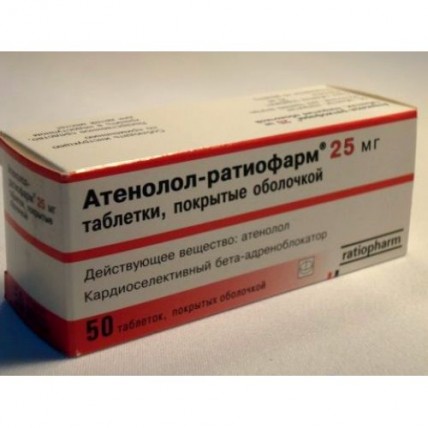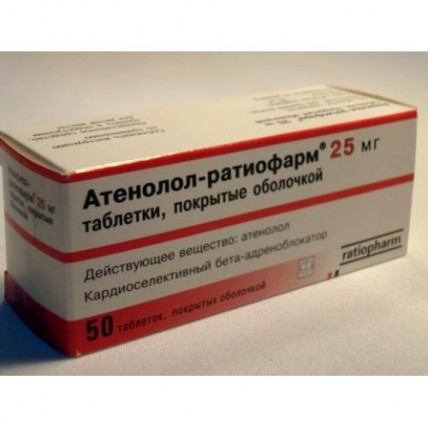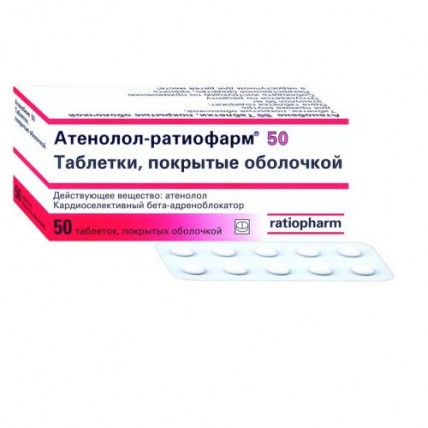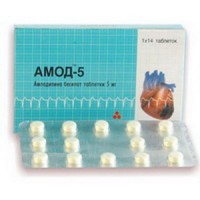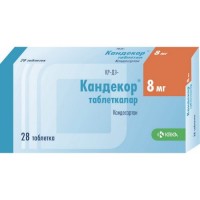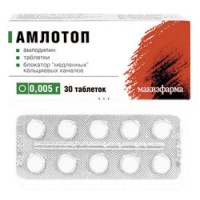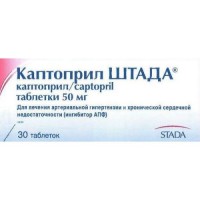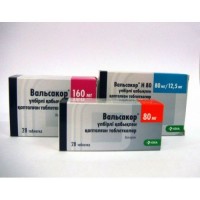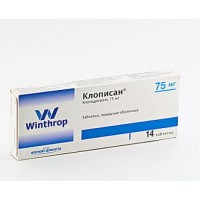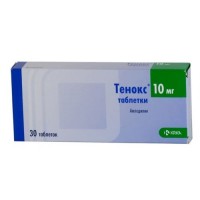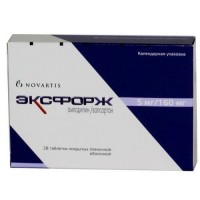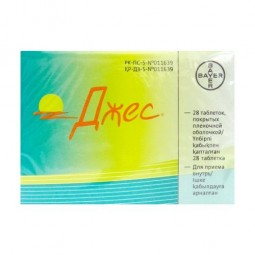Atenolol-ratsiopharm 50s 25 mg coated tablets
- $5.20
The instruction for use
of medicine for experts
of Atenolol-ratiopharm of 25 mg
the Trade name
of Atenolol-ratiopharm of 25 mg
the International unlicensed
name Atenolol Dosage Form
of the Tablet, coated, on 25 mg
Ingredients:
One tablet, coated, soderzhitaktivny substance - atenolol 25 mgvspomogatelny substances - microcrystalline cellulose, magnesium carbonate, corn starch, sodium dodetsilsulfat (a lauryl sulfate), magnesium stearate, gelatin, a gipromelloza, glycerin, titanium dioxide.
The description
White, roundish, biconvex tablets with a furrow on one party.
The pharmacotherapeutic group
Selection beta1-adrenoblockers
the Code of automatic telephone exchange C07AB03
the Pharmacological
Pharmacokinetics Later properties of oral use atenolol approximately for 50% is soaked up from digestive tract. System availability makes about 50%. The maximum level in plasma is reached in 2 – 4 hours. About 90% of atenolol within 48 hours in not changed look are removed through kidneys. Time of semi-removal of atenolol is at normal function of kidneys of 6 - 10 hours. In a terminal renal failure time of semi-removal can increase till 140 o'clock.
The pharmacodynamics
Atenolol is selection beta1-adrenoblocker, affects mainly heart beta1-adrenoceptors ('a cardioselective beta-blocker') without internal sympathomimetic activity and without membrane stabilizing action. Atenolol possesses anti-anginal, hypotensive and antiarrhytmic action. Atenolol reduces automatism of sinus node, urezhat heart rate, slows down atrioventricular conductivity, reduces contractility and excitability of a myocardium, warm emission, reduces the need of a myocardium for oxygen.
Indications
- functional disturbances from a cardiovascular system (hyperkinetic cardial syndrome, functional disturbances of regulation of arterial blood pressure)
- chronic stable and unstable stenocardia, especially in cases of a combination to tachycardia and arterial hypertension
- supraventricular (supraventricular) arrhythmias
- an additional therapeutic action in the sinus tachycardia caused by a thyrotoxicosis
- Bouveret's supraventricular disease
- blinking and an atrial flutter (in cases of inefficiency of treatment by high doses of cardiac glycosides)
- ventricular arrhythmias
- the ventricular arrhythmias caused by the increased physical activity, reception of sympathomimetic means, an introduction phase of anesthesia, including galotanovy anesthesia
- prevention of ventricular tachycardia and ventricular fibrillation
- arterial hypertension.
The route of administration and a dosage
of Atenolol-ratiopharm of 50 mg accept inside, without chewing, washing down with enough liquid (for example, water), before meal.
Doses of the drug Atenolol-ratiopharm of 50 mg and duration of treatment are established by the attending physician individually depending on the gained therapeutic effect.
It is impossible to change a dosage or to stop treatment by atenolol without council of the attending physician.
Unexpected drug withdrawal or breaks in treatment can cause heart ischemia with exacerbation of stenocardia and arterial hypertension or even to provoke a myocardial infarction. Therefore drug withdrawal and lowering of a dose have to be made slowly, stupeneobrazno.
Functional disturbances of a cardiovascular system: Usually use 25 mg of atenolol a day (1/2 tablets Atenolol-ratiopharm of 50 mg).
Chronic stable and unstable stenocardia: Usually appoint 50-100 mg of atenolol a day (1-2 tablets Atenolol-ratiopharm of 50 mg) divided into 1-2 receptions.
Arterial hypertension: Treatment usually begin 50 mg of atenolol (1 tablet Atenolol-ratiopharm of 50 mg) divided into 1-2 receptions with single use.
If necessary the day dose in a week is increased to 100 mg (2 tablets Atenolol-ratiopharm of 50 mg) divided into 1-2 receptions.
Supraventricular (supraventricular) and ventrikulyarny (ventricular) arrhythmias: Atenolol is appointed by 1-2 times a day on 50-100 mg (1-4 tablets Atenolol-ratiopharm of 50 mg).
The maximum daily dose of atenolol makes 200 mg.
In need of purpose of higher dosages Atenolol-ratiopharm of 100 mg is applied.
Side effects
In an initiation of treatment or at big dosages – dizziness, feeling of fatigue, headaches, disorders of vision, perspiration, sleep disorders, dreadful dreams, depressive disorders of mood, a hallucination
- an abdominal pain, nausea, desires on vomiting, an abdominal distension, constipations, ponosa. When lowering dosages and more careful building of doses these phenomena often pass in the subsequent spontaneously.
sometimes - dispnoe or an apnoea, at predisposed patients the emergence of a syndrome of bronchial obstruction is possible.
sometimes - bradycardia, hypotonia (orthostatic hypotonia), disturbance of atrioventricular conductivity, emergence of symptoms of heart failure
sometimes - dryness in a mouth, conjunctivitis or reduction of secretion of a lacrimal gland that especially comes to light at the patients using contact lenses
sometimes - disturbances of lipidic exchange: at the general cholesterol remaining within norm the level of lipoproteids of high density decreases and the level of triglycerides in plasma
seldom - a Werlhof's disease, aplastic anemia, thromboses
seldom - an itching, erubescence, a dieback, a photosensitization, cryesthesia increases or an itching of extremities
it is rare - muscle weakness or muscular spasms or strengthening of complaints at patients with disturbances of peripheric circulation (including patients with Reynaud's syndrome)
it is very rare - a demonstration of latent diabetes or weighting of a condition of patients with the current diabetes
it is very rare - disturbance of a libido and potency, a gynecomastia.
Contraindications
- an acute heart failure
- cardiogenic shock
- atrioventricular block of II and III degree
- a sick sinus syndrome
- sinuatrial blockade
-sinus bradycardia
- arterial hypotonia (systolic pressure is less, than 90 mm Hg)
- a metabolic acidosis
- bronchial asthma
- late stages of disturbance of peripheric circulation
- a concomitant use of monoamine oxidase inhibitors (MAO) (an exception are MAO-B inhibitors)
- hypersensitivity to atenolol and other beta blockers
- hypersensitivity to other substances of a ready dosage form.
At the Atenolol-ratiopharm drug treatment of 50 mg contraindicated intravenous administration of such blockers of calcium channels as verapamil and diltiazem, or other antiaritmik (for example, Disopyramidum). The exception is made by the patients who are in intensive care units.
Medicinal interactions
At simultaneous use of Atenolol-ratiopharm of 50 mg and:
- insulin or oral antihyperglycemic means their action can amplify or be prolonged. At the same time hypoglycemia symptoms (especially tachycardia and a tremor) can mask or disappear. Therefore it is necessary to carry out regular control of sugar to blood.
- tricyclic antidepressants, barbiturates, fenotiazin, nitroglycerine, Diuretinums, vazodilatator and other antihypertensives (for example, Prazozinum) the hypotensive effect can amplify
- blockers of calcium channels (type nifedipine), except strengthening gipotenzivnogr effect, heart failure can develop
- blockers of calcium channels (type verapamil and diltiazem) or other antiaritmik (for example, Disopyramidum) arterial hypotension, a bradika-diya and other disturbances of a heart rhythm, heart failure
- cardiac glycosides, reserpine, alpha Methyldopum can develop, a guanfatsin and a clonidine there can be a significant delay of heart rate
- Norepinephrinum and epinephrine increase in arterial blood pressure is possible
- indometacin hypotensive effect of atenolol can decrease
- drugs and anesthetics the hypotensive effect amplifies. At the same time additive, negative inotropic action of both means is shown
- peripheral muscle relaxants (for example, succinylcholine, tubocurarine) there can be strengthening of nervnomyshechny blockade. Therefore before the operation which is followed by an anesthesia, the anesthesiologist has to be informed that the patient accepts atenolol
- Euphyllinum and theophylline perhaps mutual suppression of therapeutic effects
- lidocaine can decrease its removal and the risk of toxic effect of lidocaine increases.
To the patient accepting at the same time atenolol and a clonidine, the clonidine can be cancelled only in several days after the treatment termination by atenolol.
The special
instructions Pregnancy and a lactation
Atenolol gets through a placental barrier and into maternal milk. During pregnancy (especially in the first 3 months) the advantage/risk since so far there is no sufficient experience of its use at pregnancy, especially in early terms has to be applied by Atenolol-ratiopharm of 50 mg only according to strict indications taking into account careful weighing of a ratio. If pregnant women accepted Atenolol-ratiopharm of 50 mg, then in connection with a possibility of emergence in the newborn of bradycardia, a hypoglycemia and a depression of breath stop treatment in 24-48 hours before childbirth. If it is impossible, then the newborn has to be under especially careful observation within 24-48 hours after the delivery. Atenolol gets into maternal milk. Probability of intake of active ingredient in the quantities constituting danger to the baby is very small, however babies have to be in such cases under special observation.
At patients with tendency to bronkhospastichesky reactions (especially in obstructive respiratory diseases) the bronchospasm recurrence is possible.
If at patients at treatment other beta blockers observed emergence of a Werlhof's or not Werlhof's disease, then it must be kept in mind possibility of this side effect and at treatment by atenolol.
Influence on ability of driving or potentially dangerous mechanisms
At treatment by atenolol regular medical control since in connection with specific features at some patients the disturbance of ability to run motor transport is possible and to serve moving mechanisms is necessary. Usually these phenomena are observed in an initiation of treatment, at increase in dosages and in connection with alcohol intake.
At patients with the profound renal failure of a dose of atenolol depend on the level of clearance of creatinine: at clearance of creatinine of 10-30 ml/min. of a dose lower twice, and at clearance of creatinine to less than 10 ml/min. of a dose lower by 4 times in comparison with "usual".
With extra care and only under stringent medical control it is necessary to appoint Atenolol-ratiopharm of 50 mg at the following states:
- atrioventricular block of the I degree
- diabetes with strong fluctuations of level of sugar in blood (possibility of serious hypoglycemic condition)
- abstention of meal during a religious post and heavy physical activity (emergence of serious hypoglycemic conditions)
- a pheochromocytoma is possible
- depression of function of a liver and/or kidneys (when prescribing atenolol of this category of patients the constant control behind dynamics of a functional condition of a liver and/or kidneys is necessary)
- manifest psoriasis, or psoriasis in the personal or family anamnesis
- patients with disturbance of peripheric circulation, including Reynaud's syndrome
- the patients who are on the desensibilizing therapy or with heavy allergic reactions in the anamnesis.
In all listed cases the attending physician has to weigh carefully a ratio advantage/risk when prescribing the drug Atenolol-ratiopharm of 50 mg.
Overdose
Symptoms: the clinical picture depends on degree of intoxication and is shown, generally by disturbances from cardiovascular and central nervous systems. The overdose can lead to arterial hypotension, bradycardia (up to an acute heart failure) and to cardiogenic shock. In hard cases the breath zatrudeniye, a bronchospasm, vomiting, consciousness disturbances, occasionally - generalized convulsive attacks can be observed.
Treatment: in cases of overdose or at the menacing falling of heart rate and/or arterial blood pressure, treatment with atenolol is interrupted. In the conditions of intensive care unit besides the actions directed to removal from an atenolol organism carry out tshcha-
telny observation of vital parameters and in need of them korregirut. If necessary appoint:
- atropine (0.5 - 2.0 mg in/in in the form of a bolus),
- a glucagon: an initial dose of 1-10 mg in/in (struyno), in the subsequent - 2-2.5 mg/hour in the form of long infusion,
- sympathomimetics depending on body weight and the gained effect (a dopamine, Dobutaminum, izoprenalin, oksiprenalin or adrenaline).
In bradycardia, refractory to therapy, it is possible to transfer the patient to electrocardiostimulation temporarily.
At a bronchospasm appoint beta2-sympathomimetics in the form of aerosol (at insufficiency of effect also in / c) or Aminophyllinum in / century.
In generalized convulsive attacks appoint slow in/in administration of diazepam.
The form of release and packing
of the Tablet coated on 50 mg No. 10 in the blister, on 3 or 5 blisters in a cardboard box together with the instruction for use.
Instructions on storage
to Store at a temperature not above 25ºС.
To store out of children's reach!
Not to apply a period of storage of 5 years after expiry date!
Release in drugstore
According to the prescription
Merkle GmbH Producer, Blauboyren, Germany
the Distributor
'ratiopharm GmbH', Ulm, Germany
To develop
of medicine for experts
of Atenolol-ratiopharm of 25 mg
the Trade name
of Atenolol-ratiopharm of 25 mg
the International unlicensed
name Atenolol Dosage Form
of the Tablet, coated, on 25 mg
Ingredients:
One tablet, coated, soderzhitaktivny substance - atenolol 25 mgvspomogatelny substances - microcrystalline cellulose, magnesium carbonate, corn starch, sodium dodetsilsulfat (a lauryl sulfate), magnesium stearate, gelatin, a gipromelloza, glycerin, titanium dioxide.
The description
White, roundish, biconvex tablets with a furrow on one party.
The pharmacotherapeutic group
Selection beta1-adrenoblockers
the Code of automatic telephone exchange C07AB03
the Pharmacological
Pharmacokinetics Later properties of oral use atenolol approximately for 50% is soaked up from digestive tract. System availability makes about 50%. The maximum level in plasma is reached in 2 – 4 hours. About 90% of atenolol within 48 hours in not changed look are removed through kidneys. Time of semi-removal of atenolol is at normal function of kidneys of 6 - 10 hours. In a terminal renal failure time of semi-removal can increase till 140 o'clock.
The pharmacodynamics
Atenolol is selection beta1-adrenoblocker, affects mainly heart beta1-adrenoceptors ('a cardioselective beta-blocker') without internal sympathomimetic activity and without membrane stabilizing action. Atenolol possesses anti-anginal, hypotensive and antiarrhytmic action. Atenolol reduces automatism of sinus node, urezhat heart rate, slows down atrioventricular conductivity, reduces contractility and excitability of a myocardium, warm emission, reduces the need of a myocardium for oxygen.
Indications
- functional disturbances from a cardiovascular system (hyperkinetic cardial syndrome, functional disturbances of regulation of arterial blood pressure)
- chronic stable and unstable stenocardia, especially in cases of a combination to tachycardia and arterial hypertension
- supraventricular (supraventricular) arrhythmias
- an additional therapeutic action in the sinus tachycardia caused by a thyrotoxicosis
- Bouveret's supraventricular disease
- blinking and an atrial flutter (in cases of inefficiency of treatment by high doses of cardiac glycosides)
- ventricular arrhythmias
- the ventricular arrhythmias caused by the increased physical activity, reception of sympathomimetic means, an introduction phase of anesthesia, including galotanovy anesthesia
- prevention of ventricular tachycardia and ventricular fibrillation
- arterial hypertension.
The route of administration and a dosage
of Atenolol-ratiopharm of 50 mg accept inside, without chewing, washing down with enough liquid (for example, water), before meal.
Doses of the drug Atenolol-ratiopharm of 50 mg and duration of treatment are established by the attending physician individually depending on the gained therapeutic effect.
It is impossible to change a dosage or to stop treatment by atenolol without council of the attending physician.
Unexpected drug withdrawal or breaks in treatment can cause heart ischemia with exacerbation of stenocardia and arterial hypertension or even to provoke a myocardial infarction. Therefore drug withdrawal and lowering of a dose have to be made slowly, stupeneobrazno.
Functional disturbances of a cardiovascular system: Usually use 25 mg of atenolol a day (1/2 tablets Atenolol-ratiopharm of 50 mg).
Chronic stable and unstable stenocardia: Usually appoint 50-100 mg of atenolol a day (1-2 tablets Atenolol-ratiopharm of 50 mg) divided into 1-2 receptions.
Arterial hypertension: Treatment usually begin 50 mg of atenolol (1 tablet Atenolol-ratiopharm of 50 mg) divided into 1-2 receptions with single use.
If necessary the day dose in a week is increased to 100 mg (2 tablets Atenolol-ratiopharm of 50 mg) divided into 1-2 receptions.
Supraventricular (supraventricular) and ventrikulyarny (ventricular) arrhythmias: Atenolol is appointed by 1-2 times a day on 50-100 mg (1-4 tablets Atenolol-ratiopharm of 50 mg).
The maximum daily dose of atenolol makes 200 mg.
In need of purpose of higher dosages Atenolol-ratiopharm of 100 mg is applied.
Side effects
In an initiation of treatment or at big dosages – dizziness, feeling of fatigue, headaches, disorders of vision, perspiration, sleep disorders, dreadful dreams, depressive disorders of mood, a hallucination
- an abdominal pain, nausea, desires on vomiting, an abdominal distension, constipations, ponosa. When lowering dosages and more careful building of doses these phenomena often pass in the subsequent spontaneously.
sometimes - dispnoe or an apnoea, at predisposed patients the emergence of a syndrome of bronchial obstruction is possible.
sometimes - bradycardia, hypotonia (orthostatic hypotonia), disturbance of atrioventricular conductivity, emergence of symptoms of heart failure
sometimes - dryness in a mouth, conjunctivitis or reduction of secretion of a lacrimal gland that especially comes to light at the patients using contact lenses
sometimes - disturbances of lipidic exchange: at the general cholesterol remaining within norm the level of lipoproteids of high density decreases and the level of triglycerides in plasma
seldom - a Werlhof's disease, aplastic anemia, thromboses
seldom - an itching, erubescence, a dieback, a photosensitization, cryesthesia increases or an itching of extremities
it is rare - muscle weakness or muscular spasms or strengthening of complaints at patients with disturbances of peripheric circulation (including patients with Reynaud's syndrome)
it is very rare - a demonstration of latent diabetes or weighting of a condition of patients with the current diabetes
it is very rare - disturbance of a libido and potency, a gynecomastia.
Contraindications
- an acute heart failure
- cardiogenic shock
- atrioventricular block of II and III degree
- a sick sinus syndrome
- sinuatrial blockade
-sinus bradycardia
- arterial hypotonia (systolic pressure is less, than 90 mm Hg)
- a metabolic acidosis
- bronchial asthma
- late stages of disturbance of peripheric circulation
- a concomitant use of monoamine oxidase inhibitors (MAO) (an exception are MAO-B inhibitors)
- hypersensitivity to atenolol and other beta blockers
- hypersensitivity to other substances of a ready dosage form.
At the Atenolol-ratiopharm drug treatment of 50 mg contraindicated intravenous administration of such blockers of calcium channels as verapamil and diltiazem, or other antiaritmik (for example, Disopyramidum). The exception is made by the patients who are in intensive care units.
Medicinal interactions
At simultaneous use of Atenolol-ratiopharm of 50 mg and:
- insulin or oral antihyperglycemic means their action can amplify or be prolonged. At the same time hypoglycemia symptoms (especially tachycardia and a tremor) can mask or disappear. Therefore it is necessary to carry out regular control of sugar to blood.
- tricyclic antidepressants, barbiturates, fenotiazin, nitroglycerine, Diuretinums, vazodilatator and other antihypertensives (for example, Prazozinum) the hypotensive effect can amplify
- blockers of calcium channels (type nifedipine), except strengthening gipotenzivnogr effect, heart failure can develop
- blockers of calcium channels (type verapamil and diltiazem) or other antiaritmik (for example, Disopyramidum) arterial hypotension, a bradika-diya and other disturbances of a heart rhythm, heart failure
- cardiac glycosides, reserpine, alpha Methyldopum can develop, a guanfatsin and a clonidine there can be a significant delay of heart rate
- Norepinephrinum and epinephrine increase in arterial blood pressure is possible
- indometacin hypotensive effect of atenolol can decrease
- drugs and anesthetics the hypotensive effect amplifies. At the same time additive, negative inotropic action of both means is shown
- peripheral muscle relaxants (for example, succinylcholine, tubocurarine) there can be strengthening of nervnomyshechny blockade. Therefore before the operation which is followed by an anesthesia, the anesthesiologist has to be informed that the patient accepts atenolol
- Euphyllinum and theophylline perhaps mutual suppression of therapeutic effects
- lidocaine can decrease its removal and the risk of toxic effect of lidocaine increases.
To the patient accepting at the same time atenolol and a clonidine, the clonidine can be cancelled only in several days after the treatment termination by atenolol.
The special
instructions Pregnancy and a lactation
Atenolol gets through a placental barrier and into maternal milk. During pregnancy (especially in the first 3 months) the advantage/risk since so far there is no sufficient experience of its use at pregnancy, especially in early terms has to be applied by Atenolol-ratiopharm of 50 mg only according to strict indications taking into account careful weighing of a ratio. If pregnant women accepted Atenolol-ratiopharm of 50 mg, then in connection with a possibility of emergence in the newborn of bradycardia, a hypoglycemia and a depression of breath stop treatment in 24-48 hours before childbirth. If it is impossible, then the newborn has to be under especially careful observation within 24-48 hours after the delivery. Atenolol gets into maternal milk. Probability of intake of active ingredient in the quantities constituting danger to the baby is very small, however babies have to be in such cases under special observation.
At patients with tendency to bronkhospastichesky reactions (especially in obstructive respiratory diseases) the bronchospasm recurrence is possible.
If at patients at treatment other beta blockers observed emergence of a Werlhof's or not Werlhof's disease, then it must be kept in mind possibility of this side effect and at treatment by atenolol.
Influence on ability of driving or potentially dangerous mechanisms
At treatment by atenolol regular medical control since in connection with specific features at some patients the disturbance of ability to run motor transport is possible and to serve moving mechanisms is necessary. Usually these phenomena are observed in an initiation of treatment, at increase in dosages and in connection with alcohol intake.
At patients with the profound renal failure of a dose of atenolol depend on the level of clearance of creatinine: at clearance of creatinine of 10-30 ml/min. of a dose lower twice, and at clearance of creatinine to less than 10 ml/min. of a dose lower by 4 times in comparison with "usual".
With extra care and only under stringent medical control it is necessary to appoint Atenolol-ratiopharm of 50 mg at the following states:
- atrioventricular block of the I degree
- diabetes with strong fluctuations of level of sugar in blood (possibility of serious hypoglycemic condition)
- abstention of meal during a religious post and heavy physical activity (emergence of serious hypoglycemic conditions)
- a pheochromocytoma is possible
- depression of function of a liver and/or kidneys (when prescribing atenolol of this category of patients the constant control behind dynamics of a functional condition of a liver and/or kidneys is necessary)
- manifest psoriasis, or psoriasis in the personal or family anamnesis
- patients with disturbance of peripheric circulation, including Reynaud's syndrome
- the patients who are on the desensibilizing therapy or with heavy allergic reactions in the anamnesis.
In all listed cases the attending physician has to weigh carefully a ratio advantage/risk when prescribing the drug Atenolol-ratiopharm of 50 mg.
Overdose
Symptoms: the clinical picture depends on degree of intoxication and is shown, generally by disturbances from cardiovascular and central nervous systems. The overdose can lead to arterial hypotension, bradycardia (up to an acute heart failure) and to cardiogenic shock. In hard cases the breath zatrudeniye, a bronchospasm, vomiting, consciousness disturbances, occasionally - generalized convulsive attacks can be observed.
Treatment: in cases of overdose or at the menacing falling of heart rate and/or arterial blood pressure, treatment with atenolol is interrupted. In the conditions of intensive care unit besides the actions directed to removal from an atenolol organism carry out tshcha-
telny observation of vital parameters and in need of them korregirut. If necessary appoint:
- atropine (0.5 - 2.0 mg in/in in the form of a bolus),
- a glucagon: an initial dose of 1-10 mg in/in (struyno), in the subsequent - 2-2.5 mg/hour in the form of long infusion,
- sympathomimetics depending on body weight and the gained effect (a dopamine, Dobutaminum, izoprenalin, oksiprenalin or adrenaline).
In bradycardia, refractory to therapy, it is possible to transfer the patient to electrocardiostimulation temporarily.
At a bronchospasm appoint beta2-sympathomimetics in the form of aerosol (at insufficiency of effect also in / c) or Aminophyllinum in / century.
In generalized convulsive attacks appoint slow in/in administration of diazepam.
The form of release and packing
of the Tablet coated on 50 mg No. 10 in the blister, on 3 or 5 blisters in a cardboard box together with the instruction for use.
Instructions on storage
to Store at a temperature not above 25ºС.
To store out of children's reach!
Not to apply a period of storage of 5 years after expiry date!
Release in drugstore
According to the prescription
Merkle GmbH Producer, Blauboyren, Germany
the Distributor
'ratiopharm GmbH', Ulm, Germany
To develop
